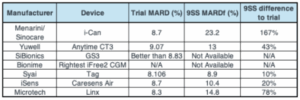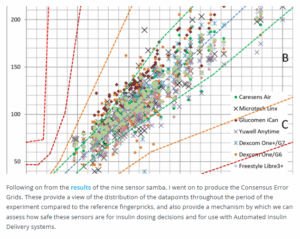In this week’s issue of The Savvy Diabetic:
-
-
- Repurposed Drugs Show Promise in Preventing T1D Progression
- Deep Dive into CGM Comparisons by Tim Street of Diabettech.com
- How to Strengthen Your Happiness Muscle
-
Repurposed Drugs Show Promise in Preventing T1D Progression by Miriam E. Tucker for Medscape.com, 19 September 2025.
 Drugs that are already approved for other purposes are showing promise in slowing disease progression in people with new-onset type 1 diabetes (T1D), according to the results of three clinical trials presented at the European Association for the Study of Diabetes (EASD) 2025 Annual Meeting.
Drugs that are already approved for other purposes are showing promise in slowing disease progression in people with new-onset type 1 diabetes (T1D), according to the results of three clinical trials presented at the European Association for the Study of Diabetes (EASD) 2025 Annual Meeting.
The MELD-ATG trial looked at using the transplantation drug antithymocyte globulin (ATG); the Ver-A-T1D trial tested the old antihypertensive drug verapamil; and the BANDIT study assessed the impact of the oral JAK inhibitor baricitinib, currently used to treat other autoimmune diseases. Trial results varied, but all therapies demonstrated potential for preserving beta cell function, although insulin treatment is still required.
“We’re seeing increasing numbers of disease-modifying therapies in stage 3 [clinical T1D] that show effectiveness and safety. Therefore, we know that we can control the immune pathway; we can also save the remaining beta cells,” co-session moderator Sanjoy Dutta, PhD, chief scientific officer of Breakthrough T1D (formerly JDRF) said.
Read more: Repurposed Drugs Show Promise in Preventing T1D Progression
Here’s a Deep Dive into CGM comparisons. Tim Street conducts extensive testing and technical details. Warning: Lots of technical info if you want to go deep … or I just pulled out the key points and conclusions.
The Nine Sensor Samba — A Sneak Peek at Simultaneous CGM Testing by Tim Street for Diabettech.com, 15 August 2025.
By any stretch of the imagination, nine CGMs are a lot to fit onto locations that are considered appropriate by the manufacturers. Fortunately, the form factor of most has reduced enough to make this easier.
-
-
-
-
-
- Dexcom One+
- Dexcom One
- Libre3+
- Libre2+
- Yuwell Anytime
- Caresens Air (non-calibrated version)
- Syai Tag
- Glucomen iCan
- Microtech Linx
-
-
-
-
 Observant readers will notice that a few are missing from the list. Those I chose not to include are: Medtronic Simplera (last trialed in March 2024), Dexcom G6 and G7 (hardware is identical to One and One+, as is performance), Medtrum Nano CGM (no change in hardware since the last trial in 2024), SiBionics GS3 (not yet available in the UK), Eversense (Currently no UK distributor and prohibitively expensive due to minor surgery requirement for installation).
Observant readers will notice that a few are missing from the list. Those I chose not to include are: Medtronic Simplera (last trialed in March 2024), Dexcom G6 and G7 (hardware is identical to One and One+, as is performance), Medtrum Nano CGM (no change in hardware since the last trial in 2024), SiBionics GS3 (not yet available in the UK), Eversense (Currently no UK distributor and prohibitively expensive due to minor surgery requirement for installation).
Primary testing model: I take 8-10 fingerpricks per day, distributed over the day, approximately 1.5 to 2 hours apart. Additionally, if a sensor says hypo or I feel hypo, if possible, I fingerprick outside of schedule and check. Where this test will differ subtly from previous experiences is that it is based on what real-world use of the systems would be. This means that I fingerprick, then take the reading displayed on the device at the time. The reason for taking this approach is that users in the real world do this.
***************************************************************
The nine sensor samba: Results revealed by Tim Street for Diabettech.com, 9 September 2025.
 Following 15 days and 150 fingerpricks, they’re here. The results of the “9 sensor samba“. And what a set of results. The biggest surprise from the test was the performance of two of the newcomers. The Syai Tag produced a set of data that was on a par with the market leaders, while the Caresens Air also made a set of figures that were in line with the Dexcom G7/One+ and Libre2+.
Following 15 days and 150 fingerpricks, they’re here. The results of the “9 sensor samba“. And what a set of results. The biggest surprise from the test was the performance of two of the newcomers. The Syai Tag produced a set of data that was on a par with the market leaders, while the Caresens Air also made a set of figures that were in line with the Dexcom G7/One+ and Libre2+.
Given that all of these results are without a single calibration taking place, they highlight the benefits of having a sensor that can be calibrated. All three of the other “newcomers” would have benefited from calibration, alongside the G6/One.
With the usual caveats about n=1 data, the key lesson from this test was that in real-world use, few of the systems get close to the values in their clinical trials, so once again, we are left with the distinct impression that MARD is a marketing tool, but not much else.
Two of the newcomers impressed me with their proximity to fingerprick values and bias, and one took that a step further with its low detection. Step forward the Caresens Air, which achieved the best results of the newcomers, with the Syai Tag taking the silver position
***************************************************************
The Nine Sensor Samba: How do the Consensus Error Grids stack up? by Tim Street for Diabettech.com, 15 September 2025.
 Following on from the results of the nine sensor samba, I went on to produce the Consensus Error Grids. These provide a view of the distribution of the datapoints throughout the period of the experiment compared to the reference fingerpricks, and also provide a mechanism by which we can assess how safe these sensors are for insulin dosing decisions and for use with Automated Insulin Delivery systems.
Following on from the results of the nine sensor samba, I went on to produce the Consensus Error Grids. These provide a view of the distribution of the datapoints throughout the period of the experiment compared to the reference fingerpricks, and also provide a mechanism by which we can assess how safe these sensors are for insulin dosing decisions and for use with Automated Insulin Delivery systems.
The error grid analysis in this n=1 suggests that even without calibrating any of the sensors, the reality is that most of the them demonstrate numbers that are nominally considered to be safe, and don’t seem to be any worse than sensors from 10 years ago (although I’d question how much difference there really is between a Libre from 2015 and a Libre3+).
Ultimately, what the CEGs, MARD numbers, Bias data, and hypoglycemia analysis all show is that no single metric is really good enough to describe the performance of a CGM system. They are complex technologies operating within a complex system, and while single datapoints make for good marketing, they don’t make for useful information in relation to system performance.
Would you choose to use any of these newcomers with an AID system? Based on the data I’ve seen in this n=1 experiment, I’d feel comfortable adding both the Syai Tag and the Caresens Air to my open-source AID system. The other newcomers? Not so much.
Read more:
How to Strengthen Your Happiness Muscle by Jenny Taitz for NYTimes.com, 5 September 2025.
 How do you find the motivation to get out there, especially when you’re feeling low, stressed, tired, or lonely? One proven strategy is to strengthen what psychologists call your reward sensitivity. Our drive to seek out happiness is a muscle that we can develop. So is our ability to relish experiences. And almost anyone can learn to amp up their reward sensitivity by training themselves to notice and savor their positive emotions.
How do you find the motivation to get out there, especially when you’re feeling low, stressed, tired, or lonely? One proven strategy is to strengthen what psychologists call your reward sensitivity. Our drive to seek out happiness is a muscle that we can develop. So is our ability to relish experiences. And almost anyone can learn to amp up their reward sensitivity by training themselves to notice and savor their positive emotions.
Most of us don’t just need to reduce pain; we also need to boost joy. In fact, improving positive emotions can be a higher priority for patients than containing their depressive symptoms. And research shows that treatments based on this idea can be effective.
An exercise to boost your reward sensitivity: To raise your reward sensitivity, you can try an exercise based on the treatment plans in these studies. Make it a daily practice for as long as it’s helpful, but commit to at least a week.
-
-
-
- Begin by planning one activity per day that will make you happy or give you a sense of accomplishment. This will make you less likely to postpone positive experiences. Be realistic — it can be as small as treating yourself to a favorite snack, reading a few pages of a novel, or FaceTiming a friend.
- After you’ve enjoyed that daily moment, close your eyes and recount out loud, in the present tense, where and when you experienced the greatest joy. Home in on details and physical sensations, like the breeze cooling your face as the sun shines. This all might feel hokey, but don’t gloss over the specifics, according to Alicia Meuret, a professor of psychology at Southern Methodist University. The idea isn’t just to remember how you felt, but to amplify and reexperience it.
-
-
Psychologists call the process of identifying and immersing in positive emotions savoring.
Here are some more subtle but powerful tweaks you can make to nurture a positive mindset.
-
-
-
- Expand your joy vocabulary: Many of us struggle to label our positive emotions much beyond fine, good or great. But research suggests that finding more words to describe those feelings can validate and intensify them, Dr. Meuret said.
- Share your highlight reel: Think about the details you typically volunteer when asked about your day or a recent trip.
- Find silver linings: With practice, it’s possible to notice the positives hidden in things that we might first see as negative, said Charlie Taylor, an associate professor of psychiatry at the University of California, San Diego, who researches social reward sensitivity.
- Forecast future wins: If looking at your calendar sparks dread, Dr. Meuret said, pick an event that’s approaching and think of the best possible outcome.
-
-
“The truth is,” said Lucas LaFreniere, an assistant professor of psychology at Skidmore College, “sometimes we need to behave like happy people if we actually want to be happy.”
Read more: How to Strengthen Your Happiness Muscle

